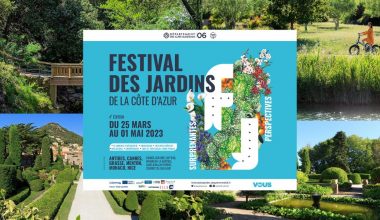From the “Remarkable” garden of the Château de La Napoule, passing through the Parc des Oliviers on the banks of Siagne, the Parc Emmanuelle de Marande -arboretum of mimosa-, without forgetting the Parc de l'Argentière on the banks of the Riou. Discover or rediscover the gardens of the city of Mandelieu-La Napoule.
Mandolocian Gardens and Parks
Garden HISTORY, parks along the banks of Siagne, furnished spaces, a breath of fresh air.

Garden Festival 2023
The Garden of the Château de La Napoule.
Labeled Remarkable Garden !
A little history ! The gardens of Château de La Napoule were fitted out in 1919 by Marie Clews, the new owner of the Château. There are classic references (French-style driveway, Italian basin and influences, small lush forest reminiscent of the English style), but also a great freedom and heterogeneity characteristic of the art of Henry and Marie Clews. The garden was originally designed as a green and white tableau. All the plants were evergreen, very few flowers in summer and only white in color and birds, also white, came to break this greenery. In addition, the garden kept an identical appearance in summer and winter.
Since 1947, the Château de La Napoule -façade and gardens is listed in the supplementary inventory of historical monuments. Maintained, as much as possible, in its original state, the garden is regularly restored and certain parts redone identically.
The main park opens with a large French-style driveway which gives the entrance to the park all its majesty. On either side of this central axis beyond the hedges that border it, we discover small green rooms, perspectives, basins, "panoramas" where the gaze escapes towards the sea, a small bridge at the among tall trees... The garden harmoniously mixes designed and constructed spaces with a “clutter” of greenery and large century-old trees. Many small hidden places, invisible from the driveway, can only be discovered by random walks.
The different gardens: the enclosure of the Castle actually shelters 4 gardens. The main garden and three other small gardens: the garden of La Mancha, the terraces on the sea and the secret garden.
The Park of Olives
A park along the banks of Siagne
The park is composed of Mediterranean species, over nearly 11 m². The trees that make it up, including a predominance of olive trees, are in keeping with the Mediterranean climate. A botanical itinerary guides the visitor throughout the Park.
Concerning the fauna, a dozen nesting boxes as well as an insect "hotel" are installed on the ash trees and the eucalyptus in association with the Environment Service and the League for the Protection of Birds (LPO). It is a real link of contemplation bordered by the Siagne river which makes this place quite bucolic.
The Argentiere Park.
Bordered by the Le Riou de l'Argentière river, it is surrounded 360° by the hills which turn yellow in winter.
It is the very last of the spaces fitted out and shared by walkers and families.
These 15m000 accommodate 2 trees, thus creating shaded areas perfect for meetings and discussions. Some meet there to settle down and play board games, the little ones have fun around the children's games set up in the heart of the garden...
Emmanuelle de Marande Park
A natural park and a mimosa arboretum.
It is one of the young gardens of Mandelieu-La Napoule! It is a mimosa arboretum considered the Mimosa Museum. The green lung of the Capitou district, the park covers nearly 10000m2. More than a hundred different species of mimosa have been planted along a promenade in the Park, punctuated by panels showing the main characteristics of the species.
NEWS! It hosts a open-air exhibition around the history of Mandelieu and the mimosa.

